Winter Skate
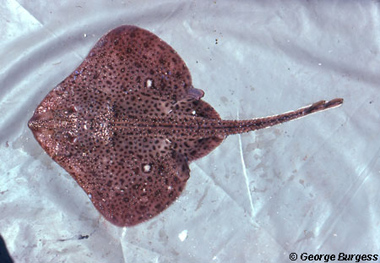
Leucoraja ocellata
These somewhat nocturnal skates have rounded snouts and lobed pectoral and pelvic fins, all light brown and covered in dark spots on top, and white with brownish blotches underneath.
They reside in the northwestern Atlantic coastal region, generally in shallows to 300 feet deep, along sandy or gravely bottoms. They release small leathery egg cases that gestate for 18 months, and the small skates tend to follow large objects after they leave the casing.
Order – Rajiiformes
Family – Rajiidae
Genus –Leucoraja
Species – ocellata
Common Names
English language common names include winter skate, big skate, eyed skate, and winter big skate. Other common names are raia-inverneira (Portuguese), raie tachetée (French), razza occhiata (Italian), spiegelrog (Dutch), täplärausku (Finnish), vinterrocka (Swedish), vinterrokke (Danish), and winterogg (Dutch).
Importance to Humans
Winter skates are taken primarily as bycatch in the trawls of the ground fishery in the Gulf of Maine and are not the target of a directed fishery. The pectoral “wings” are considered a delicacy in some regions of the world and are used to make imitation scallops.
Danger to Humans
This skate is considered harmless to humans.
Conservation
Winter skate populations have been managed by the National Marine Fisheries Service under the Northeast Skate Complex Fishery Management Plan since 2003, along with six other species (barndoor, thorny, smooth, clearnose, little, and rosette skates).
> Check the status of the winter skate at the IUCN website.
The IUCN is a global union of states, governmental agencies, and non-governmental organizations in a partnership that assesses the conservation status of species.
Geographical Distribution
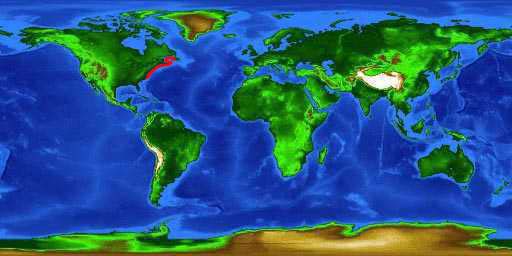
The winter skate is found in the western Atlantic Ocean from Newfoundland Banks and the southern Gulf of St. Lawrence (Canada), south to North Carolina (US). It is commonly observed in waters along the New England coast.
Habitat
Residing in waters from the surface to 300 feet (90 m) in depth, the winter skate prefers sand and gravel bottoms in shoal water in the northern portion of its range. This skate is relatively inactive during the day, with most activity occurring during the night time hours.
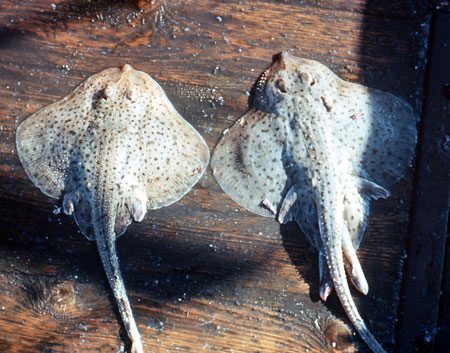
Biology
Distinctive Features
The disc of the winter skate is rounded with a blunt pectoral fin tips. The anterior margins are slightly concave for a distance close behind the snout while the posterior margins are gently convex. The snout is bluntly rounded. The first and second dorsal fins are similar size and shape. The pelvic fins are moderately concave outwardly. The tail has narrow lateral folds with males possessing claspers that trail about halfway down the length of the tail.
Coloration
The winter skate is light brown dorsally with many roundish dark spots on the disc, pelvic fins, tail, and claspers of mature males. There may also be 1-4 dark ocellar spots edged with white on the posterior portion of each pectoral fin. There is whitish translucent area on each side of the snout in front of the eyes. The ventral surface of the winter skate is usually white with irregular brownish blotches of varying sizes on the posterior portion of the disc as well as sometimes long the tail.
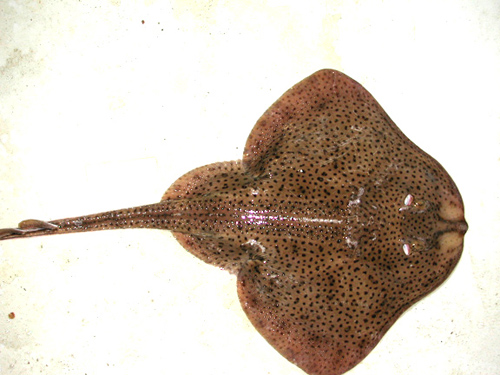
Dentition
There are 72-110 teeth in each jaw with those of the young and of females being rounded or having a blunt cusp and close set in quincunx. Mature males have teeth that are more widely spaced in transverse series and that have high conical cusps with blunt tips. The number of teeth helps to distinguish the winter skate (72-110) from the little skate (38-66).
Denticles
Young winter skates have 3-4 thorns on each shoulder and others near the eyes and along the edges of the rostral ridge to the snout tip. There is a row of 12-16 thorns along the midline of the disc and 16-18 thorns on the tail to the first dorsal fin. This row of the thorns on the tail is flanked by a second less organized row of smaller thorns from close to the pectoral girdle and by a third irregular row of yet smaller thorns lower down on either side of the midsection of the tail. Small thorns are also present on the outer anterior portion of the pectorals while the posterior corners and areas along the side of the mid-dorsal ridge are bare.
As winter skates grow, the thorns of the mid-dorsal row are lost from the disc and tail and those near the eyes decrease in number. The thorns increase in number along the shoulder and become present on the central portion of the posterior lobe of each pelvic fin.
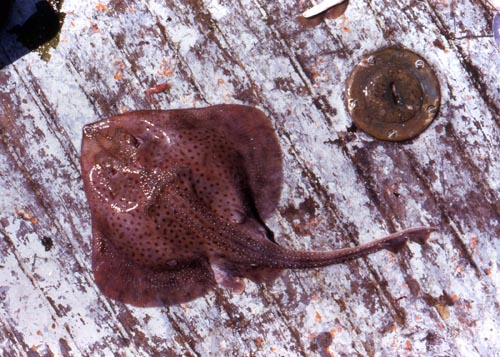
When maturity is reached, the thorns decrease along the shoulder areas, around the eyes and the rostral ridge. Bare areas expand over the majority of the inner portions of the pectorals and the posterior lobes of the pelvic fins while mature females develop large thorns that spread over the posterior corners of the pectoral fins. Alar spines are present near the snout and eyes, along the disc margins, and along the tail while the center of the tail is free of thorns.
Size, Age & Growth
The winter skate grows to approximately 41 inches (105 cm) total length and 15 pounds (7 kg) weight. Males reach sexual maturity at 11 years of age which corresponds to 29 inches (73 cm) total length while females are mature at 11-12 years of age and 30 inches (76 cm) total length. The lifespan of this skate is approximately 19 years.
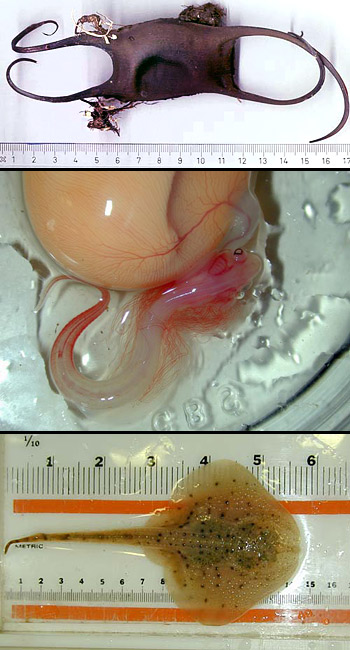
Food Habits
As a non-selective predator, the diet of the winter skate includes fish and crustaceans. In Canadian waters, the winter skate is known to feed on dollarfish, cunner, and squid.
Reproduction
Winter skates are oviparous. Although there is no defined reproductive season, winter skate reproduction peaks during the summer months. Each female produces approximately 40 egg cases per year, each containing one embryo. The egg cases are released by the female in offshore waters on rock bottom habitats. The egg cases are oblong in shape with stiff pointed horns at the corners, measuring 5.5-9.9 cm long and 3.5-5.3 cm wide.
Predators
Predators of the winter skate are primarily large fishes.
Taxonomy
The winter skate was originally described and assigned the name Raja ocellata by Mitchill 1815. The original name was later changed to the currently valid scientific name of Leucoraja ocellata (Mitchill 1815). There are no known synonyms used in scientific literature to refer to this species. The genus name Leucoraja is derived from the Greek “leykos” meaning white and the Latin “raja” meaning a fish. The species name ocellata is from the Latin “ocellatus” meaning marked with spots.
Prepared by: Cathleen Bester